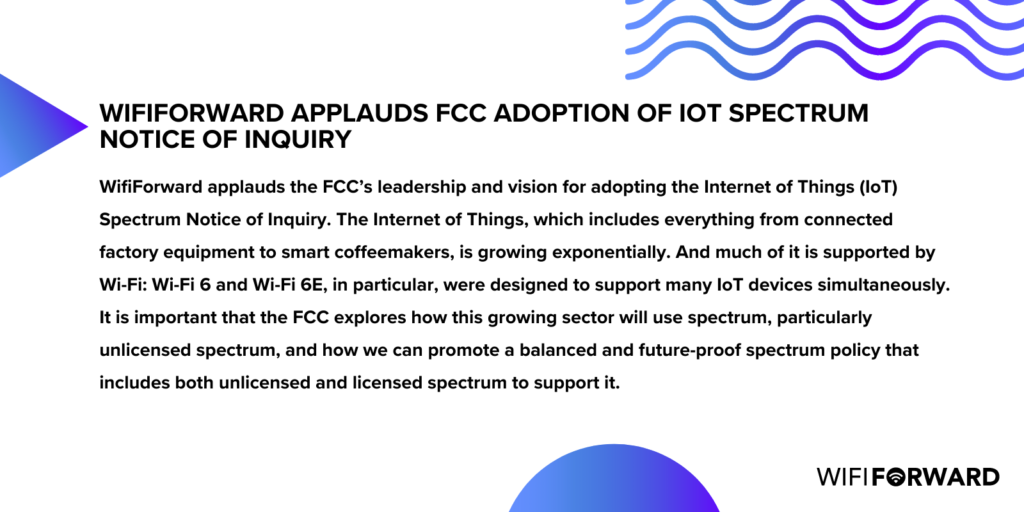Thanks for joining WifiForward’s unofficial #IoT week. It may not be an accident that “IoT” can be autocorrected to “joy” on a tiny phone screen keyboard. But what, exactly, are the “things” encompassed in this Internet of Things, that are supposed to bring us joy?
The IoT simply refers to the ever-growing collection of devices, sensors and other miscellaneous technology connected wirelessly to the internet. Alexa and Google Assistant have become commonplace and “smart home” light fixtures, security cameras, thermostats, TVs, and even ovens and refrigerators now can be purchased with Wi-Fi capabilities.
Coupled with traditional devices such as smartphones, laptops and tablets, this makes for a traffic jam of devices in our homes, all trying to reach the same wi-fi router at the same time that we’re hoping to watch Monday Night Football in 4K streaming video. But the IoT encompasses much, much more than mainstream consumer electronics and appliances.
The industrial internet of things (IIoT), for instance, allows data from workers’ hand tools and autonomous vehicles to guide manufacturers like John Deere to save time and resources, keeping costs down. IoT sensors installed by public zoos and aquariums track animal behavior and location trends, temperatures in animal enclosures, and food and water levels. The Internet of Medical Things (IoMT) includes heart monitors and laboratory sensors that provide greater accuracy to researchers, hospitals and caregivers. And of course there’s dozens of uses in the Internet of Military Things, allowing our soldiers to safely conduct dangerous missions at a distance.
The IoT is expected to swell to 20 billion devices by 2022, according to the OECD. Wi-Fi carries the bulk of the bandwidth. Without it, our mobile wireless networks would become hopelessly congested—much like you may have experienced in an overcrowded concert, parade or other public event with hundreds or thousands of other cell phones attempting to connect to the same few cell towers. But Zoom, Netflix, Hulu, FaceTime, Twitch and other data-heavy activities (or a combination of all of the above!) still occasionally prove to be too much for our in-home fixed wireless connections, as many of us discovered during the COVID-19 pandemic.
Enter the newest technology in Wi-Fi: Wi-Fi 6E and the 6 GHz band, to save the day.
The @FCC has ushered in the growth of #IoT, a burgeoning market of devices connecting to #WiFi and sustained by #unlicensed #spectrum. Said @JRosenworcelFCC: “This is exciting, but again, it’s only the start.” #InternetOfThings https://t.co/NYaRorgqUk pic.twitter.com/2i47uanwnB
— WifiForward (@WifiForward) October 15, 2021
Wi-Fi 6E refers to technology capable of using the 6 GHz band. Currently, most Wi-Fi routers broadcast over the 2.4 GHz and 5 GHz connections. Wi-Fi 6, the street name for the IEEE 802.11ax Wi-Fi standard, is the latest version of tech using the 2.4 GHz and 5 GHz bands. Add an “E” to that and you get Wi-Fi 6E, meaning the device is capable of using the 2.4 GHz, 5 GHz AND the 6 GHz band as well.
Set aside for unlicensed (Wi-Fi) use, the 6GHz band is not yet crowded with other devices, unlike the 2.4 and 5 GHz bands. Only the newest devices with Wi-Fi 6E technology are using this wide, uninterrupted section of spectrum, hence its nickname as a “wi-fi fast lane.”
The higher the bandwidth, the more data transmitted but the less range covered, so Wi-Fi 6E will particularly cater to close-proximity, high data-transfer uses such as uploading videos from your mobile phone to YouTube, video chatting, gaming, virtual reality and more. This leaves the 2.4 and 5 GHz bands open for—you guessed it—IoT.
With baby cradles, cat litter boxes, barbecue grills, houseplants, dorm bathrooms and yet-uninvented devices proliferating faster than tweets on a trending Twitter hashtag, we’ll need to make sure we’re using every last bit of spectrum in the most efficient way possible. If we don’t, we might all end up feeling like id-IoTs. (:
Happy Friday #IoT friends. Have a great weekend ahead! #smarthome #humor pic.twitter.com/mEZ4tafknR
— IoT Consortium #IoTC (@iotconsortium) August 24, 2018

